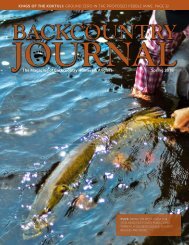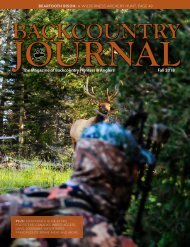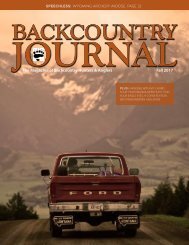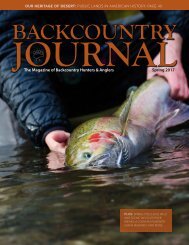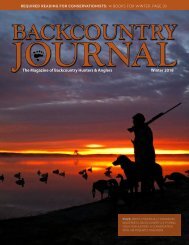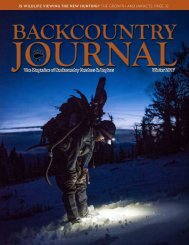BCJ_SUMMER17 Digital Edition
You also want an ePaper? Increase the reach of your titles
YUMPU automatically turns print PDFs into web optimized ePapers that Google loves.
THE FISHERMEN<br />
of the Harlem Meer<br />
BY TAIMUR AHMAD<br />
PHOTOS BY SCOTT JOHNSON<br />
MEL WHIPS HIS ROD BACK WITH A FLOURISH AS I HURRY TO GET OUT OF THE WAY. TURNING TOWARD ME, HE<br />
GRINS. “I DON’T DO NO WILD CASTS.” THE LURE SOARS ACROSS THE LAKE AND LANDS WITH A SPLASH. AS<br />
THE RIPPLES SUBSIDE, MEL BEGINS TO JIG AND HOP THE IMITATION MINNOW BACK TO SHORE. THE EVENING<br />
LIGHT REFLECTING OFF THE STEEL AND GLASS OF THE APARTMENT TOWERS SURROUNDING THE LAKE LIGHTS<br />
UP THE WATER, MAKING THE FISHING LINE GLOW. CHILDREN SHRIEK AND LAUGH IN A PLAYGROUND NEARBY.<br />
A MAN WITH A BOOM BOX ATTACHED TO HIS BICYCLE BLASTS HIPHOP AS HE PEDALS PAST. A SIREN WAILS<br />
OFF FROM NORTH OF 110 TH ST. BUT MEL IS ENTRANCED, INSULATED FROM THE NOISE OF NEW YORK CITY BY<br />
THE DEEP STANDS OF TREES AND THE GREEN LAWNS THAT FORM A BOWL AROUND THE LAKE KNOWN AS THE<br />
HARLEM MEER.<br />
Located in the northeastern corner of Central Park, the Meer<br />
is 11 acres of green, shallow water regularly stocked with bass,<br />
sunfish, crappie and several other species of gamefish that attract<br />
anglers from all over the city. Egrets, turtles and raccoons all make<br />
their homes along the lakefront, and the Meer is one of few places<br />
in the city where you can count on seeing a great blue heron<br />
stalking through the shallows. A path surrounding the water<br />
makes for an easy stroll. Though ringed by apartment towers and<br />
busy streets, the Meer retains the feel of a place apart, separated<br />
from the intensity of the surrounding city.<br />
Mel is a Meer regular and one of the core members of a community-based<br />
organization called The Fishermen that operates<br />
from its banks. He and his fellow members teach local kids how<br />
to fish – providing gear, technical instruction and lessons in the<br />
Meer’s ecology. Nat, a Vietnam veteran, 9/11 first responder and<br />
founder of the group, describes the organization as a grassroots<br />
program. “We get no funding. We get nothing. Being impoverished<br />
people from broken homes and whatnot, what we do is we<br />
try to establish this mentorship program.”<br />
The program is built around Nat’s “general orders,” a code of<br />
values and conduct printed out and distributed to the participants.<br />
The goal is to “keep the kids in a positive state of mind”<br />
by making sure they are engaged in a healthy activity like fishing<br />
in the park instead of idling in their apartments or getting into<br />
trouble on the street – a service the community appreciates. Mel<br />
takes pride in the fact that families like their kids to spend time<br />
in the park. As he put it, “They don’t want their kids getting into<br />
problems. We’d rather have them pick up a rod and a reel than a<br />
gun and a clip.”<br />
The Fishermen are made up of middle-aged to older African<br />
American men who mostly live in nearby public housing. They<br />
are at the Meer nearly every day, all day, weather and season permitting.<br />
Aside from participation in the mentorship program,<br />
The Fishermen often are unemployed. Some have previously been<br />
incarcerated and others have struggled with homelessness.<br />
As a native New Yorker with a love for the outdoors, I grew up<br />
fishing the Meer and hanging out with the characters who would<br />
congregate there. But it wasn’t until I returned to the park to conduct<br />
ethnographic research as a sociology student in college that<br />
I began to really dive into the stories of guys like Nat and Mel.<br />
44 | BACKCOUNTRY JOURNAL SUMMER 2017<br />
SUMMER 2017 BACKCOUNTRY JOURNAL | 45




